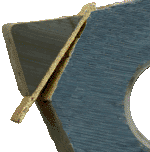When we rebuild a standard insert, we start by inspecting and gauging the tool. We check thickness, I.C., radius and extent of wear and damage. The tool is then taken to the brazing station where the insert is heated to the point where the brazed tip can be moved, and a bronze shim is inserted between the back edge of the tip and the carbide insert body. The size of the shim is  determined by the amount of wear on the tool. The tip is repositioned on the carbide blank and the tool is allowed to cool.The original tool nose radius is then ground on the tip, and the insert is face ground to ensure flatness. The overall dimensions of the tool are returned to original specification. The insert is edge prepped ( K-land and/or honed as per the original factory prep), inspected and packaged.
determined by the amount of wear on the tool. The tip is repositioned on the carbide blank and the tool is allowed to cool.The original tool nose radius is then ground on the tip, and the insert is face ground to ensure flatness. The overall dimensions of the tool are returned to original specification. The insert is edge prepped ( K-land and/or honed as per the original factory prep), inspected and packaged.
It is also possible to simply regrind the insert. In this case the tool is simply ground back far enough to get a good cutting edge, grinding off the worn or damaged material. In this case, the tool physically becomes smaller, and each tool in a batch will be different in size. There are advantages to each reconditioning method:
In a high production shop running parts with moderately tight tolerances, maintaining I.C. is important. The operator does not want to be changing offsets for each tool. He wants to change inserts, take out the offsets he made to adjust for tool wear on the previous tool, hit cycle start and get an in-spec part. In this situation, the customer would only choose a rebuilt tool.
Take the case, however, of a die shop holding tolerances of .0001 on the 3” O.D. of a $1,000.00 part. The insert is pulled and replaced when the finish goes above the desired 6 microinch finish. The operator here does not care about I.C.. He is putting each insert on a comparator to gauge the radius within a tenth before touching off and taking a rough pass to set his offsets exactly. The shop owner, on the other hand, is extremely concerned about the number of regrinds he can get from a tool since he may only get 5 parts out of a finish tool before his finish goes below his desired level. In this case, the customer is better served with a reground insert because where we might be able to rebuild the tool 3-5 times, we could regrind the insert 8-12 times since we only need to remove a one or two thousandths of an inch each time to return the tool to original cutting condition.
There is no difference in price for regrinding or rebuilding, it is the customer’s choice. In the absence of instructions to the contrary, all inserts are rebuilt to original specifications. This includes thickness of an insert. The tolerance on thickness of a CNMA432, for example is .187” thick +/- .005”. We will not grind this tool below .182 thickness without instructions from the customer. Many of our customers will use tools down to .175” to maximize number of rebuilds, but are turning very large diameter parts where center height is not a critical issue. In some cases they use under-thickness tools for certain operations where they shim the inserts to get center height back in spec.

